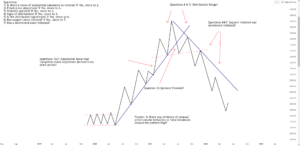CMT Association’s Market Insights features timely technical analysis of current global markets by veteran CMT charterholders. Each post appears on www.tradingview.com/u/CMT_Association/ in an effort to explain process, tools, and the responsible practice of technical analysis. Shared content and posted charts are intended to be used for informational and educational purposes only. The CMT Association does not offer, and this information shall not be understood or construed as, financial advice or investment recommendations. The information provided is not a substitute for advice from an investment professional. The CMT Association does not accept liability for any financial loss or damage our audience may incur.

Anatomy of a Top – Seven Questions for Selling Discipline by CMT_Association on TradingView.com
The equity market may be presenting a somewhat ambiguous and / or rotating profile over past months of sharp rallies and retreats, but preservation of capital comes directly from action we take with regard to the individual stocks (and / or derivatives) that we hold in our portfolio. There is ample warning to take preservation of capital actions before / if a major market decline might take place, remembering that the trend is our friend; that a stock can’t go down until it stops going up; and that most of the time (with the exception of inverted “V” tops) a period of distribution precedes a decline.
My mentor, Alan Shaw, realizing that a good deal of analytical frustration materializes simply by the lack of logical reasoning, set forth the “Seven Questions” discipline; easy rules that tend to occur more or less in the offered sequence.
First of all, when analyzing a stock or a market index for a potential reversal of trend, a simple but most important question must be asked:
- Does the stock / index have a move of substance to reverse? A major reversal formation certainly would not be looked for in a stock that has only moved from 20 to 26, but if a move from 20 to 60 or to 200 or more has been experienced, any reversal in trend could become major.
(Clearly, following gains in excess of 100% plus from the March 2009 lows (even since 2016), many stocks had rising moves of substance in place!)If the first question is answered “Yes,” we then ask: - Has the stock / index fulfilled readable price objectives? Technical analysis does generally afford the opportunity to calculate price objectives based on the size of the accumulation and / or consolidation pattern preceding the advance.
(The indexes and multiple stocks into the 2021 high achieved readable targets from the 2009 (or 2016) basing configurations and exceeded them generously.)If the answer to question 2 is “Yes,” then we move to: - Has the stock / index violated its uptrend? The occurrence of a trend violation could represent the technical forerunner, or an early warning, of a reversal in the major direction of the stock’s price movement.
(A growing number of stocks have breached their initial uptrends.)If “Yes,” question 4 then asks: - Are there signs of distribution evident? Evidence of distribution can take on many forms. Charts display certain patterns (a double top, “head-and-shoulders,” a descending triangle, or even a horizontal pattern, as examples) and pivot off the technical assumption that a “period of distribution” precedes declines; but there can also occasionally be sudden reversals from a new high.
(A number of stocks portrayed / are portraying patterns of distribution; and as some rallies approach 2021 price peaks, one may need to revisit Q 1 and Q 2 in evaluating the potential for double tops.)If “Yes,” then: - If distribution is evident, is it significant enough to imply that more than a minor movement in price could be in the offing? The greater the distribution pattern, the greater the anticipated decline.
If one has answered the first five questions in an affirmative manner “Yes,” then positions should be lightened (or protected) as the affirmative answers accumulate. Question 6 asks: - Has the stock violated a readable support level? A “Yes” answer here would represent a stop-loss discipline point, further protecting capital, and takes us to the last question, which one should not reach with a fully invested position:
- Has the stock initiated a downward trend? A “Yes” answer to this should be arrived at with positions closed (or fully protected), or use rallies to complete such action.There is a floater question which can be inserted in between any of the above seven: “Is there any evidence of unusual price and / or volume action?” Sharp upward or downward runs following a major move can often be an indication of a “climactic” phase of market action.Note: We realize that these evaluations are made more difficult and frustrating in today’s proliferation of ETFs, of hedge fund influence, electronic trading, shorting pressures without the uptick rule and intra-day algorithmic programs. But the 7 Qs apply equally to ETFs.One aspect of the above comes in the form of “false breakouts” (or false breakdowns), in which a breakout occurs without upward (or downward) follow-through. There is often evidence of these events in the progress of stocks trends. Therefore, monitoring support levels as prices may fail in their apparent breakouts becomes an important preservation of capital discipline.For an exercise in these questions, please reference the chart as an educational example.
—
Originally Posted May 22, 2023 – Anatomy of a Top – Seven Questions for Selling Discipline
Disclosure: CMT Association
Shared content and posted charts are intended to be used for informational and educational purposes only. The CMT Association does not offer, and this information shall not be understood or construed as, financial advice or investment recommendations. The information provided is not a substitute for advice from an investment professional. The CMT Association does not accept liability for any financial loss or damage our audience may incur.
Disclosure: Interactive Brokers
Information posted on IBKR Campus that is provided by third-parties does NOT constitute a recommendation that you should contract for the services of that third party. Third-party participants who contribute to IBKR Campus are independent of Interactive Brokers and Interactive Brokers does not make any representations or warranties concerning the services offered, their past or future performance, or the accuracy of the information provided by the third party. Past performance is no guarantee of future results.
This material is from CMT Association and is being posted with its permission. The views expressed in this material are solely those of the author and/or CMT Association and Interactive Brokers is not endorsing or recommending any investment or trading discussed in the material. This material is not and should not be construed as an offer to buy or sell any security. It should not be construed as research or investment advice or a recommendation to buy, sell or hold any security or commodity. This material does not and is not intended to take into account the particular financial conditions, investment objectives or requirements of individual customers. Before acting on this material, you should consider whether it is suitable for your particular circumstances and, as necessary, seek professional advice.
Disclosure: ETFs
Any discussion or mention of an ETF is not to be construed as recommendation, promotion or solicitation. All investors should review and consider associated investment risks, charges and expenses of the investment company or fund prior to investing. Before acting on this material, you should consider whether it is suitable for your particular circumstances and, as necessary, seek professional advice.


























Join The Conversation
If you have a general question, it may already be covered in our FAQs. If you have an account-specific question or concern, please reach out to Client Services.